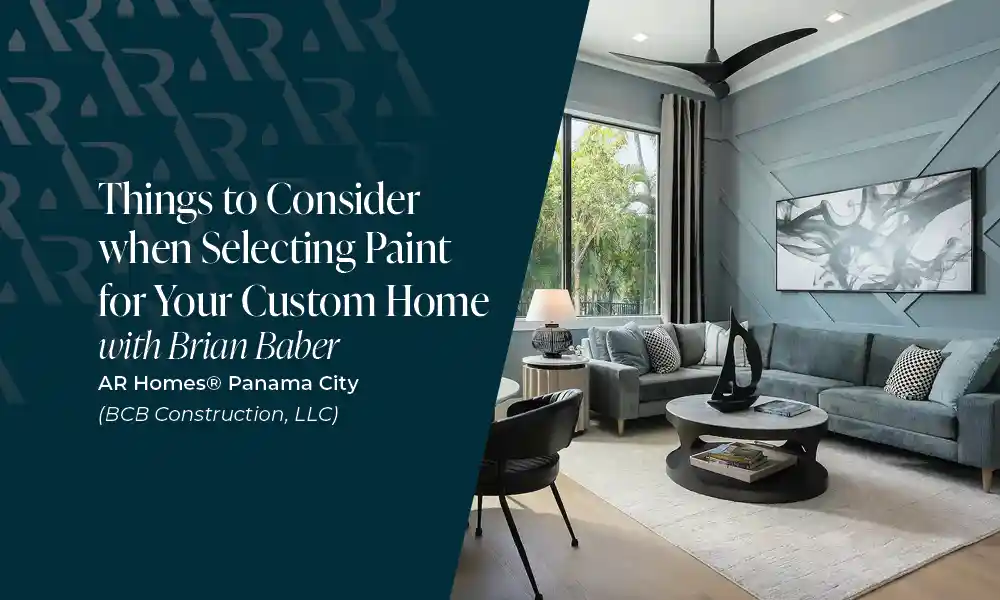Things to Consider when Selecting Paint for Your Custom Home

Things to Consider when Selecting Paint for Your Custom Home
It’s a safe assumption that everyone reading this has painted something during their lifetime. Maybe you painted your own room as a child or repainted your home because your budget didn’t allow for a professional the first time. While your past efforts were undoubtedly commendable, remember the quality of a paint job helps create the perceived quality of a home.
A marginal paint job can make a well-built, custom home look average at best. It is important to determine what you value. Consider the following when making decisions about how you’d like to paint your custom home.
Consider a “Good, Better, Best” Mentality
A “good” car covers the basics; the same is true with paint. The material costs are not the most or least expensive. The quality of the paint and painter is adequate for a custom home; the outcome is acceptable.
A “better” car is very reliable, with an above average safety rating and the perceived quality has a high, better resale value—just like a better paint job. Now, you are choosing better quality primer, paint, and caulking. Your painter is experienced and known for careful craftsmanship. This costs more, but you know what you want.
For a “best” car – think of a luxury brand you admire. The best perceived quality of the three. Here, you choose a painter with an impeccable reputation, and know that they are properly trained and committed to excellence. This is the cream of the crop, and good or better is not enough—only the best, including materials, will do.
Understanding Paint Finishes
Paint finishes are dependent on the drywall finish desired. Some paints are used to help hide imperfections, and would be used to smooth walls, but you would not want that type of paint on a texture wall.
Flat paint, which has virtually no sheen, is the commonly used finish on walls and ceilings. A flat paint is most common on walls and ceilings and is best for hiding drywall imperfections, though it is less washable, unless you specify a high-quality flat paint that can be washed.
Eggshell is just what is says. Look at the sheen of an egg, and you will get the feel for this paint finish. It is washable, but it shows more imperfections in the drywall.
Semi-gloss and gloss finishes are rarely used on interior walls because of the way the paint highlights imperfections in the drywall. Maintaining this finish is very difficult and can be very difficult to touch up. Semi-gloss paint is usually reserved for wood trim. When properly sanded and primed, a good semi-gloss finish can complement a quality trim installation.
A gloss paint finish has higher sheen than semi-gloss. It washes nicely and usually can be scrubbed. Again, beware of any imperfections in the drywall—they will be much more obvious, and if you have to touch-up, you will almost certainly notice those spots. For these reasons, gloss is almost never used on drywall.
High gloss is seldom used on walls, because walls simply are not perfect. In the sunlight, a fingernail imprint will show up on high gloss. If you consider yourself even a little picky, maintaining this finish will drive you crazy. It is virtually impossible to touch-up; therefore, it is not recommended for walls. A high-gloss finish on trim is also less desirable due to the way the trim is installed (with nails), because hiding nail holes is quite difficult with a high-gloss paint.
How Drywall Impacts Paint Selections
We should not end a paint chapter without a few words on drywall. Drywall finish is often dictated by the housing market in that area. Some areas primarily have an orange peel textured finish while others prefer a smooth finish. Drywall is often referred to as levels. Below is a description of the differences:
Level 3: Finishers apply a coat of joint compound to the tape and screws. This works in smaller areas where there are not long runs of wall that are exposed to beams of light. Often times walls with a Level 3 finish will receive a textured finish.
Level 4: This is a common drywall finish in markets where smooth drywall is preferred. Another coat of joint compound is applied to the tape and screws then sanded.
Level 5: This is considered the highest level of drywall finishing and involves applying a skim coat to the entire wall. This requires the most material and labor.
Many good builders will look at the job as a whole and chose the drywall finish in the areas that make most sense. For example, on long walls where there’s going to be a wash of sunlight, applying a Level 5 finish would make sense, where small areas such as closets might get a Level 3.
It’s important to review all of these factors when determining what type of paint to use when choosing to paint your custom home.